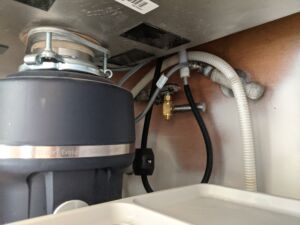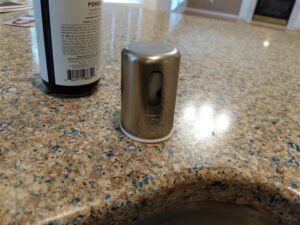A high loop or air gap is a component used in dishwashers to prevent wastewater from flowing back into the dishwasher. It is a simple but effective method to ensure proper drainage and to prevent contamination of clean dishes.
The high loop or air gap is typically installed in the dishwasher drain line, usually under the kitchen sink. It creates a gap between the dishwasher drain hose and the household drain pipe. This gap acts as a physical barrier to prevent any potential backflow of wastewater into the dishwasher.
The high loop configuration involves routing the dishwasher drain hose up to the underside of the kitchen countertop or the highest point possible, creating a loop or arch, before it connects to the drain pipe or garbage disposal unit. This loop prevents the possibility of any wastewater siphoning back into the dishwasher due to negative pressure or a blockage in the drainage system.
An air gap is a separate component that provides a visible and physical gap between the dishwasher drain hose and the household drain pipe. It is typically mounted on the sink or countertop and has a small vertical pipe that connects to the drain hose. The air gap device ensures that any wastewater from the sink or the dishwasher flows into the drain pipe without the risk of cross-contamination.
Both the high loop and air gap methods serve the same purpose of preventing wastewater backflow and are commonly required by building codes to ensure the safe operation of dishwashers. The specific requirements may vary depending on your location and local plumbing codes. The high loop configuration is required in the state of Oregon and the air gap configuration is required in Washington for all dishwasher drain line installations.
Installation of these separate backflow prevention devices can be completed with some general plumbing knowledge and the appropriate materials. Please refer to the following steps to determine whether you are comfortable with these repairs. If at any point the repairs are overwhelming for your capabilities, we recommend seeking professional assistance from a qualified plumbing contractor.
Installing a high loop at the dishwasher drain involves the following steps:

Determine the high loop position: Find the highest point under the kitchen sink or in the cabinet space where the dishwasher drain hose can be looped.
Create the high loop: Lift the dishwasher drain hose to create a loop or arch at the determined highest point. The loop should be as high as possible, reaching above the level of the sink or the flood rim level of the nearby fixtures.
Secure the high loop: Attach the highest part of the dishwasher drain hose to the underside of the countertop, the cabinet wall, or any other suitable anchor point using zip ties, clips, or hooks. There are multiple options available for purchase online that are specifically designed for this purpose and application to make this step easier and most efficient. Ensure that the loop remains in place and doesn’t sag or come loose during operation.
Connect the drain hose: Once the high loop is secured, connect the lower end of the dishwasher drain hose to the household drain pipe or garbage disposal unit. Ensure a secure and watertight connection using hose clamps or other appropriate fittings. It is important to note that if this is the initial connection at the garbage disposal, a plastic block may need to be removed within this connection point at the garbage disposal. Simply knock out this small plastic piece with a screwdriver or other tool. Be sure to retrieve this piece from within the garbage disposal using long needle nose pliers with the electrical connection disconnected at the garbage disposal prior to placing any tools within the blade compartment.
Test the installation: Run a test cycle on your dishwasher and observe the drainage. Ensure that water flows freely out of the dishwasher and through the drain hose without any leaks or backups. Verify that the high loop remains intact and does not interfere with the operation of the dishwasher.
Installing an air gap at the countertop for a dishwasher typically involves the following steps:

Locate the installation point: Choose a suitable location on your countertop for the air gap. It should be close to the sink and within reach of the dishwasher’s drain hose.
Drill a hole: Using an appropriate-sized hole saw or drill bit, create a hole in the countertop at the chosen location. Make sure the hole is large enough to accommodate the air gap device, but not too large that the escutcheon or other framing plate won’t completely cover the hole created. Prior to initiating this step, check your countertop or sink for under-utilized holes that could be retrofitted for this air gap. This can often take the form of a soap dispenser or garbage disposal button. If you can relocate your garbage disposal switch or soap dispenser easily, this may save the step of cutting into your countertop.
Install the air gap: Insert the air gap device into the hole from above the countertop. The body of the air gap should fit snugly into the hole.
Connect the hoses: Underneath the countertop, there will be two hoses connected to the air gap device. One hose comes from the dishwasher, and the other goes to the drain pipe or garbage disposal unit. Follow the manufacturer’s instructions to connect these hoses securely. Again, ensure that the plastic blockage piece at the drain connection point of the garbage disposal has been properly and safely removed.
Secure the air gap: Depending on the design of the air gap, it may have a mounting bracket or nut that needs to be tightened beneath the countertop to hold it in place. Follow the manufacturer’s guidelines for securing the air gap properly.
Test the installation: Once the air gap is installed, run a test cycle on your dishwasher to ensure that it drains properly and there are no leaks. Check for any water leakage around the air gap or under the sink.
